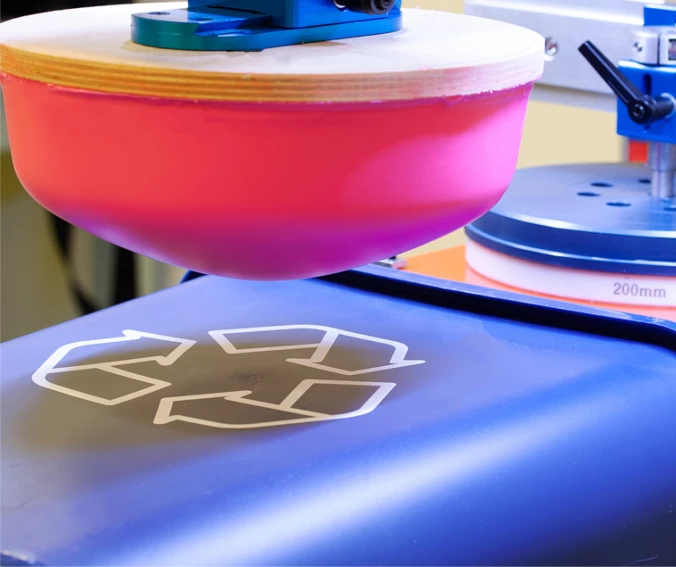MANUFACTURER OF ADVERTISING GADGETS | FAST DELIVERY TIME | FREE CONSULTING
Printing House

Pad printing - what is it?
Pad printing is an analogue process used to print on small, uneven surfaces. This technique is classified as gravure, indirect printing. It is suitable for decorating objects made of various materials: from rubber, plastic, leather and metal to wood, glass and even food products. Its name comes from the word "tampon", or stamp, which is used to apply paint from the surface of the die to the object. By the way, we also encourage you to find out what UV printing is.
Advantages of pad printing
Pad printing has a number of advantages that make this method extremely attractive. First and foremost, the process is efficient and the resulting print is highly durable. It is also resistant to negative external influences such as abrasion, chemicals and water. In addition, it covers the printed surfaces well and has a high resolution, so the results will remain legible and very effective for a long time.
See: promotional pens
Pad printing allows the perfect reproduction of specific designs and characters. As already mentioned, it allows printing even on uneven surfaces - concave, convex and many others - made of any material. It is worth adding that pad printing is a fairly cheap and fast printing method.
Disadvantages of pad printing
Pad printing also has several disadvantages. It is not suitable for printing large areas. When pad printing is used on dark or rough surfaces, then the 'beating' of the design sometimes has to be repeated twice. Metal materials, on the other hand, require a fixative to be added to the ink so that the print cannot be easily scratched off. Soft substrates pose a problem, as only one colour can be printed on them due to the difficult fit.
See: printed lanyards
Pad printing - application and operation
When it comes to pad printing the application is very wide. It can be used in product marketing by printing the logo and contact details of a company or the logo of a specific brand. A mug, key ring or pen decorated in this way will fulfil two functions - a practical one and an advertising one, which will certainly be appreciated by many customers. Pad printing can also be used to print on car parts, white goods panels, numismatic items and home furnishings. This is a way of creating a non-intrusive but effective corporate image. Company gadgets such as pens with the company logo or printed key rings are popular items in many companies, which build a sense of belonging among employees. Many brands use printed items made using this technique to improve their recognition.
A professional pad printing machine, called a pad printing machine, is needed to use this method. There are three types of pad printing machine: manual, semi-automatic and automatic. You will also need a die and a stamp (pad). A pad printing matrix is a plate made of steel or polymer on which the chosen design is engraved. Steel matrices are considered more durable and can be used on both sides. They are flat, so a suitable stamp must be used for printing on irregular surfaces. The stamp is smooth and flexible so that it adapts well to any surface. The matrix is covered with ink, the excess of which must be removed with a special scraper (squeegee). The tampon is then pressed against the master plate so that the dye is transferred onto it. The final step is to press the stamp onto the object on which the design is to be placed. Once the product has been marked, it is taken away from the machine and a clean, unprinted object takes its place.
See: syringe pen
To achieve a satisfactory result, it is important to remember to use machines and components made of tested materials of the highest quality. It is important to choose the right ink and hardener for the surface to be printed on. The ink pad must also be chosen well so that the design is applied perfectly. We have mentioned pens and key rings, but these are not the only products where we use pad printing. These also include promotional lighters and even mugs.
How many colours and what inks are used?
The number of colours that can be used depends on the type of pad printing machine. Manual pad machines can usually only use one colour. With automatic pad printers, up to twelve colours can be used at once. The inks used in pad printing offer the possibility of obtaining a shade based on the Pantone colour chart. Their selection depends on the material to be printed on.
See: medical gadgets
Pad printing is recognised as a way of advertising with the desired effect. It is durable, practical and does not require a large financial outlay. Pad printing will satisfy both CEOs of large corporations and owners of small, local businesses.
